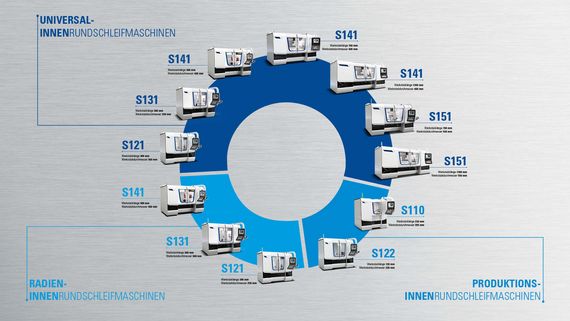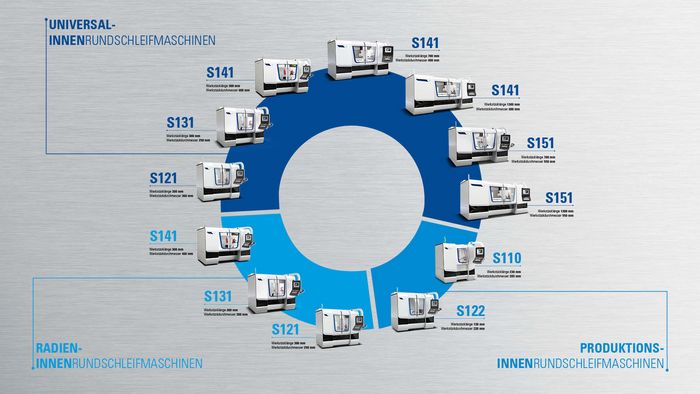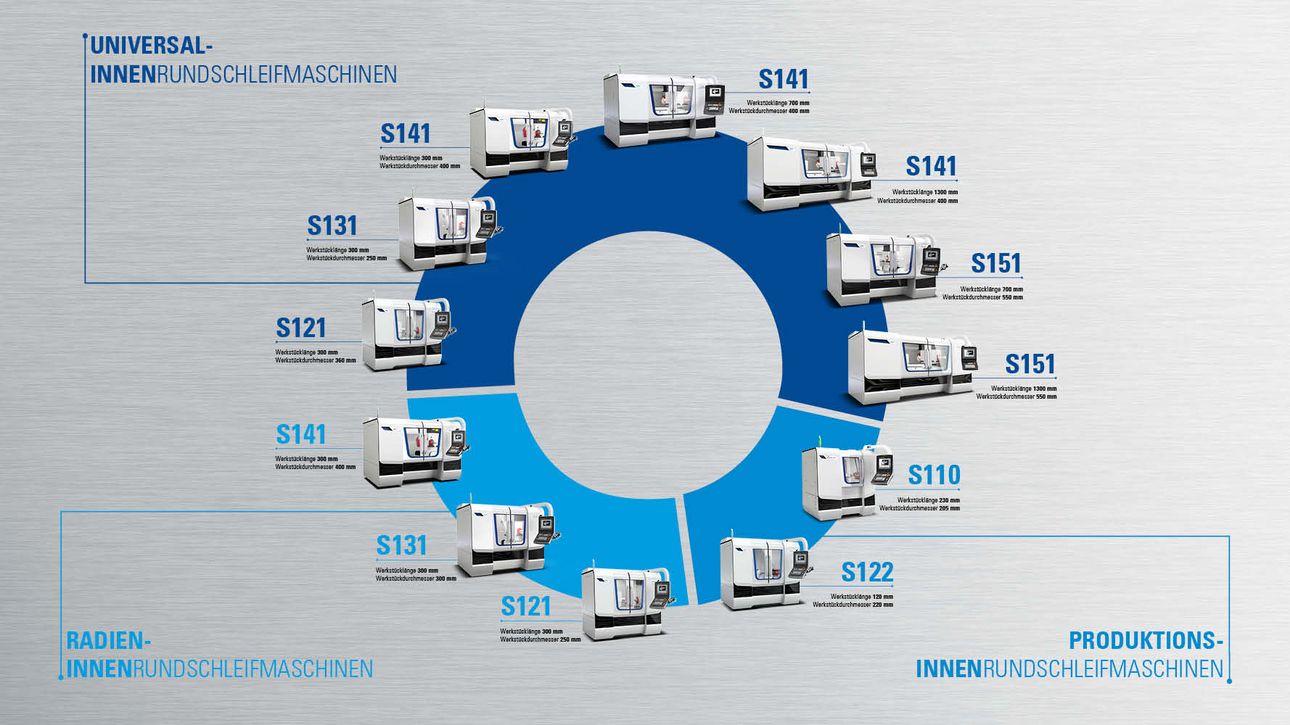STUDER - Your 360 ° solution for internal grinding
It was in 1933 when the first internal cylindrical grinder type 01 was delivered from Fritz Studer AG. 85 years later, STUDER presents with a product range of 12 machines probably the largest portfolio in the world for internal cylindrical grinding.
Kptec Components GmbH from Schorndorf (Germany) is a component manufacturer for the machine tool industry. The focus is on spindles, rotors, spindle casings, connecting rods and flange parts. The core competence is grinding. Walter Wiedenhöfer, Managing Director of Kptec Components, explains that consistently achieving tolerences in the micron range (40mill") in production is the great challenge in grinding." In the production of spindle components, coaxilities under one micron (40mill") are state-of-the-art. It is often necessary to grind an H6 fit into bores up to 400 mm (15.7") deep for the clamping interface mechanism. In addition, the machine should manufacture as economically as possible. In other words: You should only handle the component once and then completely finish it in one step. But a good machine should also flexible to enable it to handle uncommon operations such as the grinding of slots in a spindle too. One machine that meets such requirements is the universal internal cylindrical grinding machine S151. Fully equipped, it has three internal and one external grinding spindle, as well as a measuring probe. It convinced Kptec. Today Wiedenhöfer says:
The Universal
STUDER has the right machine for every demand in internal grinding. In the universal range, these are the S121, S131, S141 and the S151. The inexpensive universal S121 is the ideal machine for internal, face and external grinding of chuck components. The S131, S141 and S151 form a product range for every imaginable application in internal cylindrical grinding. They are used where very high precision and efficiency are required – for example, flange parts, spindle shafts, spindle housings, rotor shafts, bushings and much more. The maximum workpiece weight is 250kg (550lbs) and the maximum workpiece length is 1300mm (51.2").
For production
The S110 is a very flexible and compact internal cylindrical grinding machine ideal for chuck applications for indivudual parts or small series production. Thanks to its small footprint it will fit in any workshop. S122 specializes in small bores and is equipped with a swing diameter of 220 mm. It offers state-of-the-art technology for the processing of small to medium-sized workpieces in small to large-scale production. Both types can handle up to three grinding spindles in a parallel arrangement, which allows for external and internal grinding in one clamping. "Price, quality, technical standard – that was our selection criteria for a new machine. The biggest advantage is the high production capacity", says Miroslav Martinek, Production Manager at Sellier & Bellot, explaining his investment decision in an S110.
Three sizes for radii
The S121, S131 and S141 are the experts for high-precision internal cylindrical grinding of radii, spheres, cones and diameters. The maximum swing diameter is 400mm (25.6") and the maximum workpiece weight is 100kg (220lbs). The main areas of application are in the production of drawing dies made of tungsten carbide and ceramics and the production of hydraulic components such as axial pump pistons, guide plates, housings made of hardened steel, grey cast iron and copper. Complex workpieces made of industrial ceramics, sapphire and tungsten carbide for the manufacture of human implants are also within the scope of applications. The automatic B-axis with direct drive allows grinding with interpolation for the high-precision machining of radii. The Radius grinding machines are supported by the Software StuderSIM. A S131 – with an option for radius grinding – is installed at AKS Hartmetalltechnik GmbH in Schwbisch Gmünd. "The sophisticated CNC technology of combining various operations in a single clamping and thus acheiving maximum precision These criteria convinced us. The set-up times, maintenance costs and downtime are now calculable. We also benefit from the rapid response times of STUDER Customer Care", explains Production Manager Edgar Feifel.
Solid design
The internal cylindrical grinding machines are based on the Granitan® machine bed with its excellent damping proprieties and the StuderGuide® guideway system. Its huge advantage over hydrostatic guideways is the damping component in the direction of movement. The dressing process can be flexibly and optimally adapted to the workpiece, tool and material-specific properties - according to the customer's wishes. Another Studer speciality are the grinding wheel reference points (T numbers). This enables programming with normal dimensions, which considerably simplifies the programming of grinding programs. The workhead can be moved on the swiveling B-axis in the longitudinal direction, has a high roundness accuracy and is low in maintenance. An air cushion lift-off facilitates simple movement during setup and resetting.
Sophisticated sensor technology monitors the process of grinding and dressing and provides an easy detection the grinding wheel and workpiece position. The contact detection serves the purpose of cycle-time reduction. The modular spindle concept enables optimal adaptation to the grinding task. The direct drive in the grinding spindle turret head guaranties the smallest positioning variation for the radius and universal grinding machines (except S110 / S122). In the S122, the efficient high-precision processing of small diameters is also possible due to the proven grinding arbor deflection compensation.
Loading systems are available for automation that, due to their modular design, can be adapted exactly to the machine application and process. The appropriate periphery ensures seamless integration into the production process.



Everybody a grinding expert
For the operation of the machine, it is no longer necessary to be a grinding expert. All you have to do is know is the specifications of the part and what the surface finish should be at the end of the process. StuderTechnology recommends the optimal grinding parameters and generates the program. StuderWIN offers the possibility to fully integrate the measuring control and also sensor technology for process monitoring, such as contact detection and balancing systems, into the user interface. This allows uniform programming of the different systems. StuderWIN is supplemented by the grinding software StuderPictogramming. The operator lines up the individual grinding cycles together - the control generates the ISO code. The machine's functionality is enhanced by the software option for thread and form grinding. The StuderSIM software has been specially developed for the internal grinding of radii. The operating system enables programming of all basic cycles for grinding, dressing and process-supporting measurement. This type of programming guarantees high flexibility together with maximum user-friendliness. After programming, the process can be simulated and optimized. This ensures reliability, as well as guaranteeing short programming times and increased cost effectiveness.
Conclusion
There is hardly a workpiece that cannot be processed with the STUDER internal grinding machines. The Swiss grinding machine manufacturer offers the right machine for every imaginable application. Very pleasant for the operator is the optimal ergonomics, which further increases the relative value of the machines.



